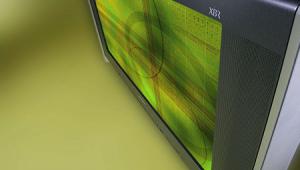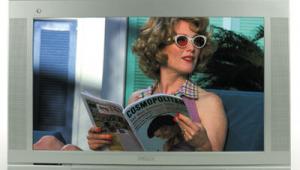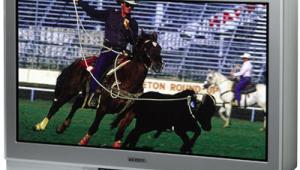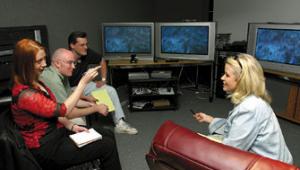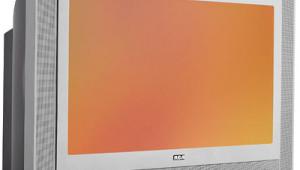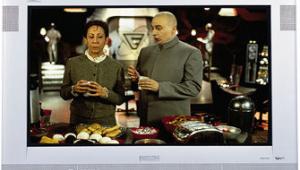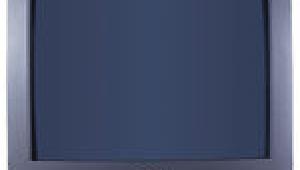Toshiba 34HF84 CRT HD Monitor
It's hard to talk about CRTs these days. Sure, they still make up the majority of the display market, but they're just not sexy. It's like a Toyota Camry—it does everything it's supposed to do, and it does it well, but no one really lusts after it. That analogy is probably too harsh for the Toshiba 34HF84, which has more-accurate colors and a darker black level than any display I've reviewed in recent memory.
Aesthetically, the 34HF84 isn't terribly attractive. Perhaps I've been spoiled by the mountains of plasmas I've reviewed recently, or maybe this TV's styling is just a little plain in a frosted/powdered world. For the money, though, this doesn't matter one bit. When the lights are off, all TVs are judged on an even playing field.
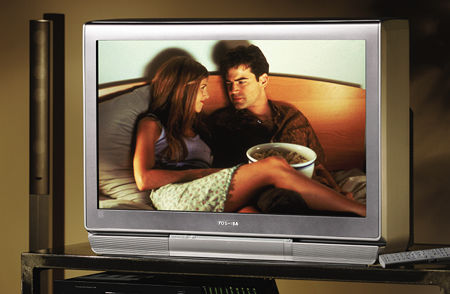
I know people are tired of hearing about the black level of CRTs; however, when you're used to the grayish-blacks of most digital displays, seeing an actual black on a display is a relief to the eyes. The 34HF84's black level is so good, it was too dark to measure using our LS-100 light meter. This certainly makes obtaining an accurate contrast-ratio measurement nearly (OK, completely) impossible; however, with a white field of 15.32 foot-lamberts and a black level too dark to measure, suffice it to say that the 34HF84's contrast ratio is significantly better than anything we've measured since we started doing contrast-ratio measurements.
This was most noticeable during my opening barrage of movies, starting with Master and Commander. The notoriously difficult dark opening scene looks like a murky mess on most digital displays; on the Toshiba, it looked less like a torture test and more like a movie. In one scene, a sailor is walking below deck early in the morning. He's carrying a lantern, so parts of the screen are well lit, while others are buried in shadows or are completely dark. On the Toshiba, the black parts blended with our listening room's surrounding darkness, while the shadows blended seamlessly with both the image's dark parts and the lantern's light. Even the best digital displays don't look this good with this material.
The term filmlike is thrown about a lot, and, while that's an admirable goal for many displays, the true goal is to be lifelike. If the display can fool your eyes and brain into not thinking about the display at all, you're inevitably going to be completely absorbed in the movie. A deep black level is a big step toward that goal. A high contrast ratio is a good next step. The last step, and one that's overlooked by consumers and manufacturers alike, is color.
Almost every digital display we've reviewed recently has had color points that are at least slightly off the SMPTE spec. Those that are undersaturated look washed-out and tend to create a very boring image, even if everything else is accurate. Fortunately, few displays err in this direction. Almost all reveal varying degrees of oversaturation. It's easy to understand why companies would choose to do this. On the show floor, the TV with the brightest image and the most color is usually the one that people look at the most and, therefore, usually buy.
Worse case scenario, the display looks cartoonish. Even in less-severe instances, though, the colors just don't look entirely natural. While this inaccuracy can sometimes be subtle, if the 34HF84 were sitting beside any other TV, the other set's color inaccuracy would become brutally obvious. Greens aren't the color of apple-flavored Jolly Ranchers. Reds aren't the color of me after a trip to the beach (go ahead, picture that one). There's a naturalness to the image that's sorely missing from most current displays—not just in the primary colors, but in the colors in between, as well.
The 34HF84's processing is pretty good. The TV picked up the 3:2 sequence fairly quickly, which is rare for a display. I saw some slight stairstepping in diagonal lines, but it was fairly minimal and less than what you'll find with most displays. You can select between 540p and 1080i (the only scan rate available); with most sources, the difference wasn't noticeable.
The 34HF84 doesn't have a lot of light output, but it's not dim. The 15 ft-L you see in the measurements box is about all you'll get without blooming; however, if you want to drive it a little harder (at the expense of accuracy), you should be able to get a little more light out of it. At 15 ft-L, though, it's watchable with the room lights on, although sunlight will certainly make viewing difficult (as with most TVs).
 While you're in the menu system during setup, make sure you start your adjustments from the movie mode, as this is the only mode without severe scan velocity modulation (it's been awhile since you've read those three words in this magazine, eh?). SVM causes the TV to adjust the speed of the electron gun to make edges artificially sharp at the expense of actual resolution and fine detail. In the movie mode, this wasn't an issue, and the picture seemed sharper as a result.
While you're in the menu system during setup, make sure you start your adjustments from the movie mode, as this is the only mode without severe scan velocity modulation (it's been awhile since you've read those three words in this magazine, eh?). SVM causes the TV to adjust the speed of the electron gun to make edges artificially sharp at the expense of actual resolution and fine detail. In the movie mode, this wasn't an issue, and the picture seemed sharper as a result.
Speaking of sharp, our measurements show that the 34HF84 wasn't as detailed as other sets we've reviewed around this size. From a normal viewing distance, you won't miss the resolution, as the image looked extremely detailed. If you want to move closer, the small amount of video noise is more of an issue than the resolution. Compared with the amount of video noise in most plasmas, it's hardly noticeable.
Setup is crucial with any display, and perhaps more so with a CRT. Out of the box, the set is blooming and blue, with out-of-control SVM. The beauty is that you can fix most of the problems in the user menu, and your local ISF tech (www.imagingscience.com) can fix almost all of them.
Out of the box, slight convergence and geometry problems were visible in test patterns. With actual video material, neither was really noticeable. If you really want to tweak it, an ISF tech should be able to fix the latter with little difficulty.
On the functionality side of things, the remote is well laid-out and completely backlit. While there are no direct input-access buttons, the TV/video button pulls up a menu from which you can select the input of your choice using the number pad or cycle through the inputs one by one. In an odd processing quirk, aspect-ratio adjustment is available for all input signals except 720p.
In the end, this TV's Achilles heel is its size. For most home theaters, 34 inches just doesn't cut it anymore. For the money, this is a good set for a bedroom or other smaller room (if you're sitting about 82 inches away). It's disappointing that the set doesn't have an HDTV tuner; but, at $1,600, it's not unreasonable for there not to be one.
I wish this level of picture quality were available in much larger screen sizes. Maybe someday it will be. In the meantime, this set is an inexpensive way to see what you're missing in the big digital displays or in your old NTSC direct-view. If you're looking for a way to get HD into your bedroom, the 34HF84 gives you some of the best color and black level we've seen in a long time at a very reasonable price.
Highlights
• Incredibly accurate color
• A great black level (duh, it's a CRT)
